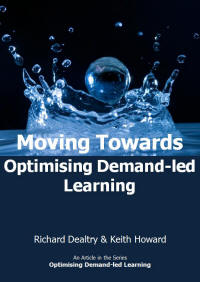The 2005-2007 ECUANET Leonardo Da Vinci Project: Optimising Demand-Led Learning
This article summarises the management execution and findings of the programme styled ECUANET (European Corporate Universities and Academies Network) – an EC Leonardo Da Vinci Project
Purpose:
The purpose of this paper is to present the key project learning points and outcomes as a guideline for the future quality management of demand-led learning and development.
Design / Methodology / Approach:
This article has been designed to assist the process of innovation diffusion relating to a major European project. It explicates the key positive and obscure dynamics that the project team had to conjure with, in reaching recommendations about best practice in corporate university and enterprise academy design and management.
The research methodology was based upon a corporate university blueprint architecture and browser toolkit developed by a member of the team to provide depth in practice evidence and a searchable database for comparative case to case practice evaluation.
Findings:
It was found that the corporate university organization and business development concept is a subject area which is either well understood by company management and education institutions or there is considerable confusion about its role and purpose. In large part this arises from the very different interpretation in the concept’s development and practice across the world, region by region.
From a wide and diverse portfolio of companies and organizations who where invited to participate in the action research case studies those who accepted have one very important characteristic in common: they are all intensively engaged in managing a major innovation i.e. they already have the commitment to making new ideas work in practice. In addition it also demands serious reflection about the creative nature of the learning leadership role and also the style of its management.
Practical implications:
The results of the project show that a successful corporate university intervention needs to be founded upon a sustainable commitment by top management who should promote, if not present already, a spirit of curiosity leading to better ways of doing business today and in the future. It requires an in-depth understanding of the organizations strategic learning needs and good knowledge of the models of corporate university development that are available and reliable.
Originality / Value:
The a priori browser based corporate university blueprint model architecture employed in the empirical case study research mode proved to have both the depth and flexibility to provide a high quality evaluative framework and capture all the dynamics relating to the key variables in good corporate university design and management.
The data base of case foundation information, key performance indicators (KPIs) and best practice outcomes will be one of the most comprehensive and world class quality reference sources published to date
The variables that make up the portfolios of emergent best practices – process and management – have originality and value both individually and collectively. The impact of these best practice ways of working will have far reaching consequences for leadership and the future shape of lifelong interdependent learning between employers and employees and policy in government departments and education institutions.
Click To View Abstracts From Our Articles Below
Research Reports:
- Frequently asked questions with reference to the corporate university
- Case research into corporate university developments
- Case research into the evolution of a corporate university development process
- Envisioning development
- ECUANET – European Corporate Academies Transnational Best Practice Network
- Interim reflections on the corporate university and SME academy business development innovation and its diffusion
- Moving towards optimising demand-led learning – the 2005-2007 ECUANET Leonardo Da Vinci project
Strategic Management:
- Strategic directions in the management of the corporate university paradigm
- Managing intellectual leadership in corporate value
- The real-time corporate university becomes a reality
- The savvy learner
- Integrating programme and process performance QA
- Global corporate priorities and demand-led strategies
Managing Design Parameters:
- Managing the corporate university learning curve
- Establishing a methodology for appraising the strategic potential of the corporate university
- Configuring the corporate university – managing a portfolio of thinking schools
- How to configure the corporate university for success
- Issues relating to learning accreditation in corporate university management
- Design and management of an organization’s lifelong learning curriculum
Best Practice Management:
- Engendering corporate scholarship for top level management performance
- Managing the transition to the corporate university – a synthesis of client research
- Managing the issue of learning relevance in the formulation of corporate learning strategies
- Managing the corporate university watershed
- The new generation of corporate universities – co-creating sustainable enterprise and business development solutions
- The corporate university’s role in managing an epoch in learning organization innovation
- Configuring the structure and administration of learning management
- Exploration of a contextual management framework for strategic learning alliances
- Hunting goodwill along the intellectual equity trail




